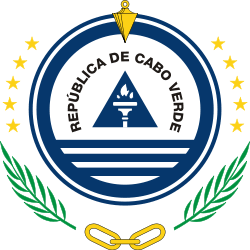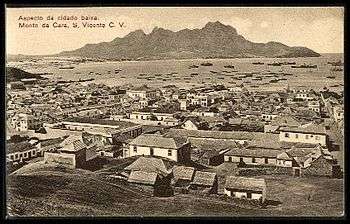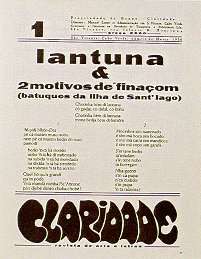Timeline of São Vicente, Cape Verde
Part of a series on the |
|---|
| History of Cape Verde |
 |
| Colonial history |
| Independence struggle |
|
|
The following is a timeline of the island of Santiago, Cape Verde.
Prehistoric era
- Up to about 5,000 years ago: The island was larger and compromised an estimate size of 1,500 km2 of land, the name of the island that included Santa Luzia and two other islets was likely called the "Northwestern Island". Flooding took place and broke up into three main islands and other islands, one became the current island of São Vicente.
- Up to about 4,000 years ago: Ilhéu dos Passaros separated from the island, the small peninsula shrank up to its current size.
Colonial era
See also: Timeline of Portuguese Cape Verde
- 1462 - January 22 - The island was discovered on Saint Vincent's Day
- 1734 - The island's first fortification built to protect against British, French and Dutch pirates.
- 1781 - Pirate raids continued to raid, a plan for a new settlement was made.
- 1795 - The island's first permanent settlement Mindelo, then as Aldeia de Nossa Senhora da Luz was founded
- 1819
- Population: 120
- Nossa Senhora da Luz planned to rename itself to Leopoldinha after empress Maria Leopoldina of Austria, wife of Peter IV of Portugal
- 1821 - Population: 295
- 1838
- Porto Grande became a coal deposit was established to supply ships on Atlantic routes
- The city adopted the new name Mindelo after the military expedition in the beaches of Mindelo, Portugal during the Wars of Liberation.
- Mindelo planned to become capital of Cape Verde replacing Praia, many people wanted the capital to remain in Praia, the capital did not move.
- 1845 - Construction began on Our Lady of the Light Pro-Cathedral or Mindelo Pro-Cathedral, it was not completed until 1963
- 1850 - Population: around 1,400
- 1852 - Fortim d'El-Rei or Fortim do Mindelo built
- 1857 - March 10: Slavery abolished on the island, the first in Cape Verde
- 1861 - A custom house in the port of Mindelo built by governor Januário Correia de Almeida.[1]
- 1874 - Two submarine or telegraph cables linked with the island, they are now as communication cables or lines, via Madeira, it connected with Brazil in the capital of Pernambuco, Recife.
- 1875 - Coal shipping company Cory Brothers established
- 1879 - 669 ships were refueled each year at Mindelo
_p0173_CAPE_VERDES%2C_PORTO_GRANDE.jpg)
Porto Grande Bay, the island's north and northwest and its telegraph lines in the 1884 map by Imray

Old postcard of Mindelo from the early 20th century
- 1880 - Mindelo Library (Biblioteca do Mindelo) first opened, one of the first two libraries opened in Cape Verde[2]
- 1885 - A telegraph line with Cameroon via Bathurst (now Banjul), Gambia established
- 1890 - Population: 6,666
- 1894
- Farol de D. Amélia in the southwest of the island built
- A branch of the Portuguese bank for the colonies, the Banco National Ultramarino opened, it would remain until 1975 when it was replaced with the Bank of Cape Verde
- Early 20th century - Santo Antão Municipality, also as Santo Antão-São Vicente (Northwestern Cape Verde) Municipality split into Santo Antão and São Vicente Municipalities, Santa Luzia, which belonged to São Nicolau Municipality integrated into the municipality of São Vicente
- 1912 - Mindelo was the most used Transatlantic telegraph station for some time
- 1921 - Liceu Nacional de Infante D. Henrique (now Escola de Jorge Barbosa) opened
- 1922
- Eden Park, a picture house, the nation's first cinema opened[3]
- May 25: CS Mindelense, Cape Verde's first football (soccer) club established
- 1929 - August 5: FC Derby football (soccer) club established
- 1930 - Population: 14,639
- 1930s - Economic crisis started mainly after the Great Depression and famines struck the island
- 1936 - Claridade, a literary review inaugurated in Mindelo
 Claridade, a literary review published in Mindelo between 1936 and 1960, it was a cultural and a social movement towards and indepedent Cape Verde
Claridade, a literary review published in Mindelo between 1936 and 1960, it was a cultural and a social movement towards and indepedent Cape Verde - 1938 - Cape Verde's first football (soccer) competition began, the São Vicente Island League began, it was also a national competition that was unofficial until 1953
- 1940
- Population: 15 848[4]
- April 1: Académica do Mindelo football (soccer) club founded
- 1950 - Population: 19 576[4]
- 1952 - Last refueling of coal to a ship done, the remainder was done by diesel
- 1960
- Population: 20 705[4]
- São Pedro Airport first opened, the country's second airport to be opened, since 2011, it is now known as Cesária Évora Airport
- August 19: Falcões do Norte football (soccer) club founded
- 1962 - Porto Grande expanded
- 1963 - Our Lady of the Light Pro-Cathedral or Mindelo Cathedral completed
- 1970 - Population: 31 578[4] (the largest 10-year population addition in percentage numbers: 52.514%)
- 1974:
- Rádio Barlavento started radio broadcasting, it was Cape Verde's first radio station
- April: the Carnation Revolution took place in Portugal, the Estado Novo regime collapsed, Cape Verde became an autonomous province
- Mid-year: the final Cape Verdean colonial championships took place
After independence in 1975-1999
- 1975
- July 5: Cape Verde declared independence from Portugal and became and independent nation
- Newspaper Terra Nova founded, the first newspaper mainly served for the island
- 1980 - Population: 41 594[4]
- 1981 - May 5: Batuque FC football (soccer) club founded[5]
- 1982 - April 17: Electricidade e Água do Mindelo became part of the national electric company Electra
- 1984 - Festival de Baía das Gatas, Cape Verde's first major music festival held its first edition
- 1987 - September 9: Corinthians São Vicente football (soccer) club established
- 1988 - Newspaper Jornal O Cidadão founded
- 1990 - Population: 51 277[4]
- 1991 - April 15: Newspaper Artiletra founded
- 1992 - Estádio Municipal Adérito Sena sports complex opened
- 1997 - Second expansion as part of the Porto Grande Modernization Project, the length would be 1,750 m
21st century
- 2000 - Population: 67 163 - the largest 10-year population addition (15,886 added)[6]
- 2001 - São Vicente Cup and Super Cup established
- 2003
- Mindelo became the cultural capital of the Portuguese Speaking Countries
- June 9: Instituto de Estudos Superiores Isidoro da Graça or IESIG established in Mindelo[7]

The city of Mindelo along with Monte Cara, Porto Grande Bay and Canal de São Vicente
- 2006
- University of Cape Verde established, the Mindelo campus was formed
- Cape Verdean Atmospherical Observatory: Humberto Duarte Fonseca, named after Humberto Duarte Fonseca opened, it was a bilateral initiative by Germany and the United Kingdom and is located in the area of Ribeira do Calhau.[8]
- Around May: The then-Queen of Spain Sofia visited Mindelo
- May and June: NATO maneuvers occurred on the island, 7,800 troops took part in Operation Jaguar[9]
- 2009 - Fortim do Mindelo's touristic project began
- 2010 - Population: 79 374[6]
- Around 2011 - Completion of Mindelo's windmills southwest of Mindelo
- 2012 or 2013 - the road connecting Calhau and Baía das Gatas through the east shore of the island was completed
- 2013
- Third expansion of Porto Grande in the north
- November 12: Porto Grande Bay became the fifth most beautiful bay in the world.[10]
- 2014 - UCV's Mindelo campus enlarged in the eastern portion
See also
- Timeline of Boa Vista, Cape Verde
- Timeline of Brava, Cape Verde
- Timeline of Fogo, Cape Verde
- Timeline of Maio, Cape Verde
- Timeline of Sal, Cape Verde
- Timeline of Santiago, Cape Verde
- Timeline of Santo Antão, Cape Verde
- Timeline of São Nicolau, Cape Verde
References
- ↑ "Nobreza de Portugal e do Brasil", Direcção de Afonso Eduardo Martins Zúquete, Editorial Enciclopédia, 2.ª Edição, Lisboa, 1989, Volume Terceiro, p. 320
- ↑ Cristóvão, Fernando (2006). Dicionário Temático da Lusofonia. Texto Editores, Lisbon, Luanda, Praia and Maputo. p. 148. ISBN 972-47-2935-4.
- ↑ Arenas, Fernando (2011). Lusophone Africa: Beyond Independence. U of Minnesota Press. p. 131. ISBN 978-0-8166-6983-7.
- 1 2 3 4 5 6 Source: Statoids
- ↑ "Batuque FC". Soccerway. Perform Group. Retrieved 21 April 2015.
- 1 2 Source: Instituto Nacional de Estatísticas.
- ↑ IESIG website
- ↑ http://www.asemana.publ.cv/spip.php?article63831 (Portuguese)
- ↑ "Landung auf den Kapverden" [Landing in Cape Verde]. BZ Online (Berliner Zeitung) (in German). 26 June 2006.
- ↑ "Porto Grande do Mindelo é a 5ª baía mais bela do mundo" [Porto Grande Near Mindelo, the 5th Most Beautiful Bay in the World]. A Semana (in Portuguese). 12 November 2013. Retrieved 16 July 2016.
This article is issued from Wikipedia - version of the 12/5/2016. The text is available under the Creative Commons Attribution/Share Alike but additional terms may apply for the media files.